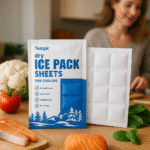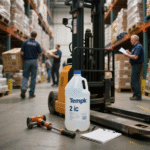Beim Versand verderblicher Waren, maintaining a stable temperature is critical to ensuring product integrity. Trockeneisbeutel, aus massivem Kohlendioxid hergestellt (Co₂), offer a powerful solution to keep items frozen during transit. As the cold chain logistics industry evolves in 2025, understanding the latest regulations, Best Practices, and innovative trends in using dry ice for shipping is crucial for compliance and safety.
Was sind Trockeneisbeutel für den Versand?
Dry ice packs are sheets, Blöcke, or pellets of solid CO₂, designed to keep temperature-sensitive products at ultra-low temperatures. Im Gegensatz zu herkömmlichem Eis, dry ice sublimates directly into gas without leaving behind any liquid residue. This feature makes it ideal for shipping items that require freezing, wie Pharmazeutika, Biologische Proben, and certain perishable foods.
Why Use Dry Ice for Shipping?
Dry ice packs are an excellent choice for shipping due to their unique properties, providing several advantages over traditional cooling methods.
-
Long-Lasting Cooling Power: Dry ice sublimates at a much slower rate than regular ice, ensuring your goods remain cold for longer durations.
-
No Moisture Runoff: Since dry ice does not melt into water, there’s no risk of water damage to sensitive items.
-
Ideal for Extended Transit: For shipments lasting more than 48 Std., dry ice is often the preferred choice for keeping goods frozen.
2025 Regulations for Shipping Dry Ice
Shipping dry ice is subject to strict regulations due to its classification as a hazardous material. In 2025, the following key regulations must be adhered to when shipping dry ice:
-
UN -Nummer: Packages containing dry ice must be clearly labeled with the UN number “1845.”
-
Klasse 9 Hazard Label: Eine Klasse 9 hazardous materials label must be affixed to the package.
-
Gewichtserklärung: The net weight of dry ice in kilograms must be marked on the package.
-
Venting Requirements: Packaging must allow CO₂ gas to escape to avoid pressure buildup during sublimation.
Für Lufttransport, Die Internationale Luftverkehrsvereinigung (Iata) limits the amount of dry ice per package to 2.5 kg on passenger aircraft and up to 200 kg on cargo flights.
Best Practices for Using Dry Ice Packs in Shipping
To ensure the safe and efficient use of dry ice for shipping, Folgen Sie diesen Best Practices:
1. Select Appropriate Packaging
-
Isolierte Behälter: Use insulated coolers or Styrofoam containers to maintain the desired temperature.
-
Entlüftungsverpackung: Ensure the container has ventilation holes to allow CO₂ gas to escape during sublimation.
-
Cushioning: Properly secure items inside the packaging to prevent damage during transit.
2. Calculate the Amount of Dry Ice
Determine the quantity of dry ice based on the transit duration and the perishability of the goods. A common guideline is to use 2.5 kg of dry ice for every 24 Stunden des Versands.
3. Label Packages Correctly
-
Mark the package clearly with “Trockeneis” oder “Kohlendioxid, Solid.”
-
Binden Sie die an UN -Nummer (1845) Und Klasse 9 Hazard Label.
-
Specify the net weight of dry ice in kilograms.
Häufige Fehler zu vermeiden
-
Sealed Containers: Never use airtight containers to pack dry ice; this can cause dangerous pressure buildup.
-
Falsche Kennzeichnung: Ensure all required labels are attached to avoid delays or rejections by shipping carriers.
-
Exceeding Weight Limits: Stick to the weight regulations to prevent violations of hazardous materials rules.
Alternativen zum Trockeneis
While dry ice is effective, several alternatives may be more suitable depending on your shipment requirements:
-
Gelpackungen: Reusable and non-hazardous, ideal for shorter transit times.
-
Phasenwechselmaterial (PCMs): These materials maintain specific temperature ranges and are reusable, offering a more sustainable option.
-
Traditionelle Eisbeutel: While cheaper, ice packs can leave water residue, potentially damaging goods.
Sustainability and Trends in Dry Ice Shipping
In 2025, several emerging trends are shaping the dry ice shipping industry, focused on both environmental sustainability and technological advancements.
1. Nachhaltige Trockeneisproduktion
Many suppliers are shifting toward environmentally friendly production methods by capturing CO₂ from industrial processes, such as ammonia synthesis, reducing the overall carbon footprint of dry ice.
2. Hybrid Packaging Solutions
Hybrid solutions combining dry ice and PCMs are gaining popularity. These packouts minimize CO₂ use while extending the cooling duration, making them more eco-friendly.
3. Smart Packaging and Tracking Technology
Innovations such as smart CO₂ sensors and QR-coded labels allow for real-time tracking of dry ice and product temperatures, ensuring better monitoring and compliance.
How to Store Dry Ice Packs for Shipping
Proper storage is essential to maximize the shelf life and effectiveness of dry ice packs:
-
Store in an Insulated Container: Use coolers or specially designed containers to slow sublimation.
-
Vermeiden Sie versiegelte Behälter: Never store dry ice in airtight or sealed containers; always ensure proper ventilation.
-
Sublimationsraten überwachen: Keep track of the rate at which dry ice sublimates to ensure the correct temperature is maintained.
Frequently Asked Questions About Dry Ice for Shipping
Q1: Wie lange dauert Trockeis während des Versands??
Trockeneis kann dazwischen dauern 18 Zu 24 hours depending on the type of packaging and external conditions. Blocks of dry ice last longer than pellets.
Q2: Is dry ice safe to ship?
Ja, dry ice is safe for shipping when packaged according to safety guidelines, including proper ventilation and labeling.
Q3: Kann zum Versand von Lebensmitteln verwendet werden, um Lebensmittel zu versenden?
Ja, dry ice is commonly used for shipping frozen and perishable foods, as long as the necessary safety measures are followed.
Schlussfolgerung und Empfehlungen
Dry ice packs are a powerful tool for shipping temperature-sensitive products in 2025. By choosing the right supplier and adhering to best practices for packaging, Lagerung, und Sicherheit, you can ensure that your products arrive at their destination in optimal condition.
Aktionsplan:
-
Determine the required temperature range Für Ihre Sendung (gefroren gegen gekühlt).
-
Calculate the correct amount of dry ice based on shipment duration.
-
Verify regulatory compliance and ensure proper packaging and labeling.
-
Consider hybrid packaging solutions to improve sustainability and cost-efficiency.
Über Tempk
Tempk is a leading provider of cold chain packaging solutions, offering high-quality dry ice and other thermal control products to ensure the safe and efficient transport of temperature-sensitive goods. We specialize in helping businesses optimize their logistics while adhering to all relevant safety and regulatory standards.
Wenden Sie sich noch heute an Tempk to learn more about our dry ice solutions and how we can help streamline your cold chain shipments.























